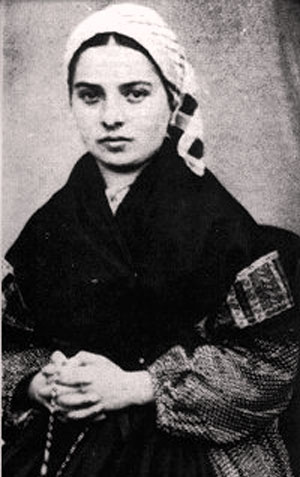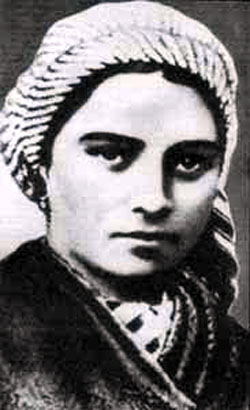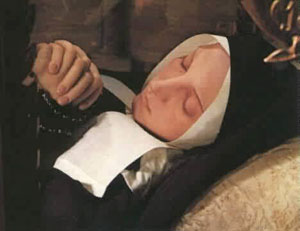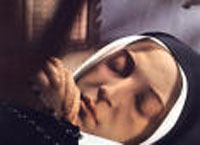 |
The Saint of the Day
St. Bernadette Soubirous, April 16
Prof. Plinio Corrêa de Oliveira
Biographical selection:
Bernadette, whose complete name is Marie Bernarde Soubirous, was a child like any other. Only her gaze was extraordinary, showing a great innocence. In the first apparition, she learned to make the sign of the Cross by following the gestures of Our Lady. From the fact that she learned it from Our Lady, witnesses used to say that during her whole life St. Bernadette always made a sign of Cross that was unforgettable and incomparable.

St. Bernadette Soubirous, 1844-1879
|
In the Convent in Nevers that Bernadette later entered, some nuns were once insisting that she describe the cloth of the dress of Our Lady to resolve a quarrel. Some said it was a certain kind of material, others another. Bernadette responded:
“I never said that the material was of this or that kind. I only said that it was made from a material that I had never seen before. But if you are so interested in knowing this, why don’t you ask her to appear to you and then you can pay attention to it.”
She was a very humble person. Once someone asked her to say a few words for the edification of the novices. She answered smiling: “I don’t know anything! No one can take anything good from a stone.”
The Mother Superior asked her if she were not proud to be chosen as a confidante of Our Lady. She answered: “What idea do you have of me? The Holy Virgin only chose me because I was the most ignorant. If she could have found someone else more ignorant, she would have chosen her.”
The continuous suffering and vomiting of blood she experienced slowly weakened Bernadette. Her physical appearance became pitiable. Once a postulant came to see her so that she might know the seer. As the saint passed by, a companion pointed her out and said with scorn: “Bernadette? It’s just this!” (Bernadette, c’est ça!)
Comments of Prof. Plinio:
St. Bernadette Soubirous was a peasant from an area in the Pyrenees that is half French, half Spanish, which constitutes, from a certain point of view, a synthesis of France and Spain. If you pay attention to her photos – not the sentimental statues in some churches – you find a person with a slightly square face with regular lines, a dark gaze, large eyes, and a certain fixed look that is Spanish. The French gaze is normally rapid, quickly moving to analyze you, and then moves on to another thing. But the Spanish gaze nails you and remains steadfast, analyzing everything about you, a kind of X-ray.
She also had a nose that was more Spanish than French, which gave coherence to her whole physiognomy. It is a line that marks the face from top to bottom. She also had another Spanish characteristic of saying things straightforwardly.

A penetrating gaze and straight nose give coherence to her whole physiognomy
|
She was always completely at ease, like a person who does not pretend to be anything more that what she is. She was humble before others, but when it came to the service of Our Lady, she did not care about the opinion of anyone else.
She was always unpretentious. Once, when she had to stand before the police to explain her revelations, she impressed her interrogators with her naturalness. But before her parents, the parish priest, and her religious superior, she was a model of respect and obedience.
Here you have the spirit of a true Catholic, of a true saint. She never gave importance to the world’s values, she didn’t care about what other people were thinking about her, be it good or bad. If someone gives importance to the applause of the world, he ends by losing his liberty and relying on the applause to go ahead. The applause becomes the music he needs in order to keep dancing. To be able to enjoy complete serenity, one has to be independent of the opinion of the world. St. Bernadette Soubirous was one who did not care about that. She used to do what her duty was according to Holy Mother Church.
St. Bernadette converted many persons who saw her making the sign of the Cross. She had learned to do so from Our Lady, who is the perfect model of a friend and lover of the Cross of Jesus Christ. For this reason St. Bernadette also had a love for suffering and for the Cross of Our Lord that propitiated her to receive from Our Lady something more of her spirit when the Virgin Mary made the sign of the Cross. Something of Our Lady’s majesty passed to her.
Once I read a report by a lady of high society who witnessed St. Bernadette during an apparition. This lady wrote that she have had never seen a young lady of the aristocracy who had the bearing and refinement of St. Bernadette during the apparition, even though she was a simple peasant. This is because she was in communication with the Queen of Heaven and Earth, and something of her royalty was transmitted to St. Bernadette. It was not only majesty, but also a state of virtue that passed from Our Lady to her.
So, many people witnessing this transformation in the peasant girl realized that she was in contact with some person whom they did not see, but whom they sensed was there. They realized that this person was Our Lady and many of them converted. It is an interesting principle to consider that the true devotee of Our Lady receives something of her in his soul and his bearing. There is a certain communication from her to him.
The answers she gave to the nuns in the selection are indicative of her vivacious personality and sense of humor. She was a keen polemicist and sometimes her responses were sharp.

Above, the body of St. Bernadette, lightly coated with wax, remains incorrupt. It is in the chapel dedicated to her at her Order's motherhouse in Nevers. Below, a close-up of her face, serious and serene in death
 |
About her humility, what she said about herself was true. Our Lady chose her because she was the most ignorant in Lourdes. Her ignorance was notable and stood as one proof of the veracity of the revelations, because she could never have imagined them. She was a simple, unlearned person who could not have known on her own the things she said Our Lady told her, and she could not even fully understand some parts of the revelations. Her ignorance stood as an important argument in favor of the Lourdes apparitions.
Finally, she was short and even if she had a lively spirit, she did not stand out readily. Then she became sick and her physical appearance used to give a bad impression, which is why she was scorned by some of her companions.
The selection does not say, but an important aspect of her life is that she offered all her suffering for the sanctification of a certain person. No one knows who this mysterious sinner was, because she never revealed the name. Probably it was a soul that Divine Providence showed to her and asked her to suffer for. Was he a man from her time, or someone from the future? No one knows.
Another curious point in her life reported in good biographies is that Our Lady revealed a secret to her, but Bernadette never said a word about the content. Perhaps the secret was related to that mysterious sinner for whom she was asked to suffer. So, in the three great apparitions of Our Lady – La Salette, Lourdes and Fatima – there were secrets transmitted by her.
Let us ask St. Bernadette to give us a great devotion to Our Lady, a devotion like hers that had something of the virtue of Our Lady. Let us also ask her to protect one of her sister seers, Sister Lucy of Fatima, and give her the strength to be faithful to her mission. Something that is always reason for concern is the fight Sister Lucia has to make to be faithful to the secret she knows.

Left, the grotto of Lourdes where Our Lady appeared to Bernadette each day for 15 days. Right, The Basilica of Lourdes that stands over the grotto today.
|


  | | Prof. Plinio Corrêa de Oliveira | |
The Saint of the Day features highlights from the lives of saints based on comments made by the late Prof. Plinio Corrêa de Oliveira. Following the example of St. John Bosco who used to make similar talks for the boys of his College, each evening it was Prof. Plinio’s custom to make a short commentary on the lives of the next day’s saint in a meeting for youth in order to encourage them in the practice of virtue and love for the Catholic Church. TIA thought that its readers could profit from these valuable commentaries.
The texts of both the biographical data and the comments come from personal notes taken by Atila S. Guimarães from 1964 to 1995. Given the fact that the source is a personal notebook, it is possible that at times the biographic notes transcribed here will not rigorously follow the original text read by Prof. Plinio. The commentaries have also been adapted and translated for TIA’s site.
|
Saint of the Day | Home | Books | CDs | Search | Contact Us | Donate

© 2002- Tradition in Action, Inc. All Rights Reserved
|
 |

|